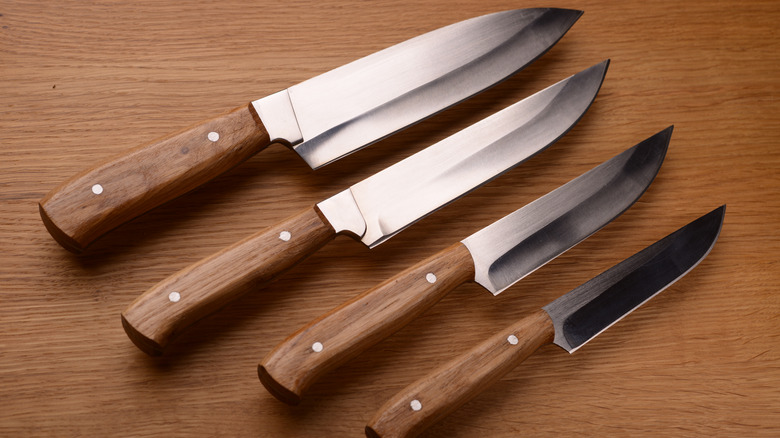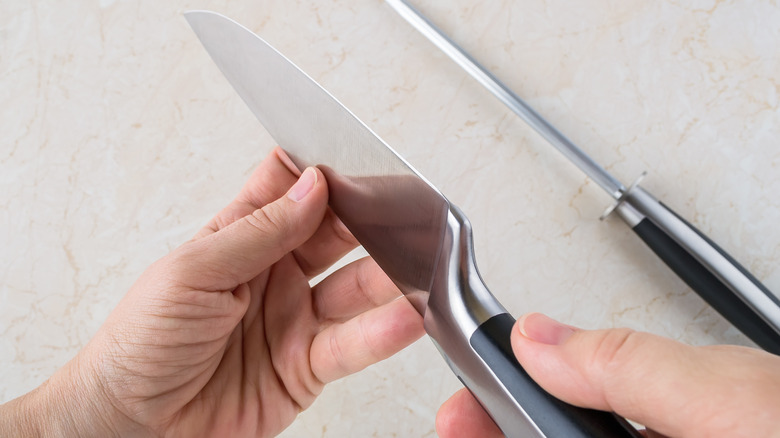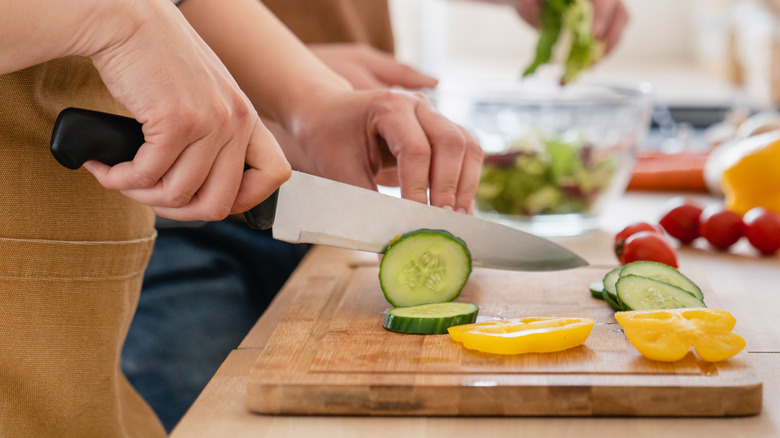What Makes Carbon Steel And Stainless Steel Knives Different?
Knives are a prized possession in the kitchen. A beautiful knife not only gets the job done but looks impressive in a knife block and seems to command a certain air of authority. Contrary to popular belief, where you get your knife and how much it costs isn't as important as what it's made of.
There are two kings of the kitchen — the carbon steel knife and the stainless steel knife. When properly maintained, they can last for years, and if they don't, companies like Wüsthof and Cutco boast lifetime warranties and will replace your knives if they chip or break. The costs for carbon and stainless steel kitchen knives can range widely, but what exactly are you paying for? Both types are made of iron. Both can be sharpened at home. Both claim unparalleled sharpness. But what's the difference, and is one knife better than the other?
Carbon steel holds an edge
Carbon steel is a mix of iron and carbon. According to Wasabi, carbon steel should be between 98-99% iron and 1-2% carbon. Pure iron is soft, so carbon is added to harden the blade, and this combination makes a carbon steel knife so desirable. Because of its hardness, carbon steel retains its sharpness for much longer than stainless steel and makes at-home sharpening much simpler. Wildest Road writes that the high carbon content gives this knife "superior sharpness and edge retention."
There is a downside, though. Chipping can occur more easily in a carbon steel knife versus a stainless steel knife. Extreme pressure, dropping, or sudden impact could crack the blade. Another downside to carbon steel knives is the high rust factor. Moisture and acidic foods can cause a high-carbon steel knife to rust within hours. However, there is a type of black rust that's considered a desirable patina rather than corrosive. This patina can even serve as a protective coating for carbon steel, preventing further rusting, according to Wasabi. The patina is caused by oxidation on the blade from moisture.
A carbon steel knife requires more care to prevent corrosion from iron oxide rust. Hunker suggests washing your carbon steel knife immediately after use, drying thoroughly, and lightly rubbing the blade with food-grade mineral oil before storing. This will prevent rust from developing instead of the protective and attractive patina.
Stainless steel is rust resistant
Stainless steel knives contain iron and carbon but have an added element of chromium. This addition is what makes these blades stainless or rust-resistant and more forgiving with acidic foods and moisture. According to Wasabi, stainless steel knives usually remain shiny and do not develop a patina. The iron content is about 70-88% while the chromium content is between 10-14% — to be considered stainless, they must contain at least 10.5% chromium.
Their resistance to water, acid, and humidity makes stainless steel knives the more popular choice, says Wildest Road. The addition of chromium makes a stainless steel blade more flexible and absorbs impact better than carbon steel knives.
One downside to stainless is that it does not retain its sharp edge as well as a carbon knife. Also, in the production of these knives, some of the chromium becomes chromium carbide which is very hard, which can make it difficult to develop a new cutting edge. Carbon steel will hold its sharp edge longer and is more receptive to sharpening. Because they are not as hard as carbon steel knives, stainless steel knives' cutting durability is lower as well (via Wasabi).
Since each knife has pros and cons; the choice depends upon the habits and desired maintenance level of the home cook. Happy cutting!


